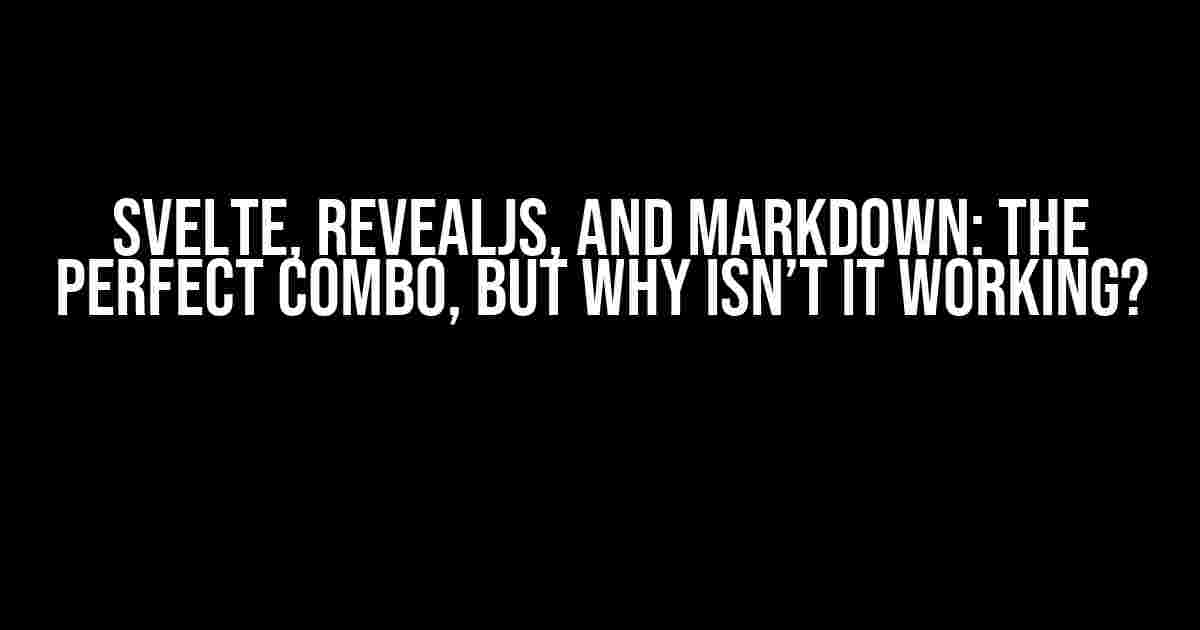Are you tired of wrestling with Svelte, RevealJS, and Markdown, trying to get them to play nice together? You’re not alone! Many developers have struggled to get these powerful tools to work in harmony, only to be left frustrated and confused. But fear not, dear reader, for we’re about to dive into the world of Svelte, RevealJS, and Markdown, and uncover the secrets to making them work seamlessly together.
What’s the Problem?
So, what’s the issue? You’ve got Svelte, a lightweight and customizable JavaScript framework, RevealJS, a fantastic presentation library, and Markdown, a simple and easy-to-use formatting language. On paper, it sounds like a match made in heaven. But when you try to use them together, things start to go awry. Your Markdown content doesn’t show up, or it’s not being rendered correctly. What’s going on?
Svelte and Markdown: A Love-Hate Relationship
The problem lies in the way Svelte and Markdown interact. Markdown is a formatting language that’s meant to be easy to read and write, but it’s not native to Svelte. Svelte, on the other hand, is a JavaScript framework that’s designed to be highly customizable, but it doesn’t natively support Markdown. This means that when you try to use Markdown in a Svelte component, it doesn’t get rendered correctly.
RevealJS: The Missing Piece
Enter RevealJS, a presentation library that’s designed to work seamlessly with Markdown. RevealJS takes your Markdown content and renders it beautifully, with sleek transitions and animations. But, when you try to use RevealJS with Svelte, things get complicated. RevealJS expects your Markdown content to be in a specific format, which Svelte doesn’t provide out of the box.
The Solution: Using Svelte with RevealJS and Markdown
So, how do we get Svelte, RevealJS, and Markdown to work together in perfect harmony? The solution is to use a combination of Svelte’s built-in features, RevealJS’s Markdown rendering capabilities, and a little bit of creative problem-solving. Let’s dive in!
Step 1: Create a New Svelte Project
First, let’s create a new Svelte project. You can do this by running the following command in your terminal:
npx degit sveltejs/template my-svelte-appThis will create a new Svelte project called “my-svelte-app” with the basic file structure.
Step 2: Install RevealJS
Next, let’s install RevealJS. You can do this by running the following command in your terminal:
npm install reveal.jsThis will install RevealJS and its dependencies.
Step 3: Create a New Svelte Component
Now, let’s create a new Svelte component that will hold our Markdown content. Create a new file called “Presentation.svelte” in the “src” directory:
<script>
import Markdown from 'markdown';
import Reveal from 'reveal.js';
</script>
<div>
<h1>My Presentation</h1>
<!-- Markdown content will go here -->
</div>
This component imports the Markdown library and the RevealJS library. We’ll use these later to render our Markdown content.
Step 4: Add Markdown Content
Now, let’s add some Markdown content to our component. Create a new file called “presentation.md” in the “src” directory:
# My Presentation
This is a sample presentation using Markdown and RevealJS.
## Slide 1
Hello, world!
## Slide 2
This is another slide.
### Slide 2.1
This is a nested slide.
This is our Markdown content. We’ll use RevealJS to render this content later.
Step 5: Use RevealJS to Render Markdown Content
Now, let’s use RevealJS to render our Markdown content. Update the “Presentation.svelte” file to look like this:
<script>
import Markdown from 'markdown';
import Reveal from 'reveal.js';
let markdownContent = '';
const markdownFile = 'presentation.md';
fetch(markdownFile)
.then(response => response.text())
.then(text => {
markdownContent = Markdown.parse(text);
});
$: {
const deck = Reveal.initialize({
markdown: {
separator: /
